The First Vision taught and confirmed many of the most significant and distinct truths of the Restoration to the Prophet Joseph Smith. Today, the First Vision is one of the most fundamental aspects of Mormonism’s story—an event beaten only in significance by the events of Jesus the Christ’s life and Atonement. It has not always been considered to be such a fundamental principle of Mormonism. This vision, however, has assumed the position that it has within Mormon thought for good reason, since Mormon conceptions of apostasy, revelation, and the nature of God can find their roots in Joseph Smith’s First Vision.
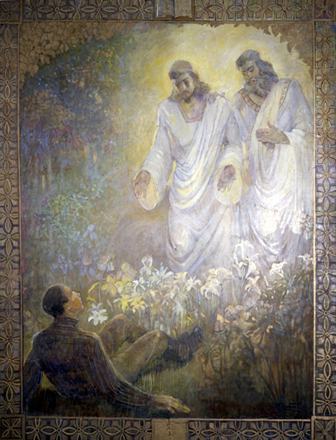
Minerva Teichert, The First Vision
The First Vision has only become important to Mormonism with time and reflection. Mormon historian James B. Allen published an important study of contemporary documents from Joseph Smith’s lifetime and found that the First Vision was rarely discussed. Accounts of the First Vision produced in the 1830s were often personal in nature and often were discussed as a prelude to the events of the Book of Mormon coming forth. It wasn’t until Orson Pratt published his Interesting Account of Several Remarkable Visions in 1840 that an account of the vision even became available to the public. There are a number of indications that Joseph discussed the First Vision privately with individuals throughout the 1830s and 1840s and may have mentioned it briefly in passing in one or two public sermons, but it was far from a central tenet.[1] For example, even when Joseph mentioned the First Vision in a June 1843 sermon, only Levi Richards included the reference in his journal while Willard Richards, Wilford Woodruff, Franklin D. Richards, and Eliza R. Snow passed over the reference in their records of the sermon, some of which were far more extensive than Levi Richard’s entry.[2] This indicates that during the early years of the Restoration, the First Vision was not considered to be the great, founding experience of Mormonism.
Even in the decades following Joseph’s death, the First Vision only gradually entered into Mormon thought. A few apostles such as Orson Pratt, Willard Richards, Lorenzo Snow, and John Taylor made mention of the First Vision in pamphlets published after the death of the Prophet Joseph Smith. Most of the time, however, the coming forth of the Book of Mormon was the focus of missionary tracts, since it fulfilled the prophesy of restoration in Revelation 14:6, where St. John declared: “And I saw another angel fly in the midst of heaven, having the everlasting gospel to preach unto them that dwell on the earth.” For the most part, when the story of the First Vision was brought up it was to emphasize that Joseph had been called as a prophet. The Pearl of Great Price—where the most famous account of the First Vision is found—was published initially in 1851 as a missionary tract and was only canonized in 1880. Not coincidentally, it was around the 1880s that the First Vision began to be depicted in art and music and to be referenced more frequently in the public sermons of leaders like George Q. Cannon and B. H. Roberts. By the early 20th century, the First Vision had assumed a foundational place in Latter-day Saint thought.[3]
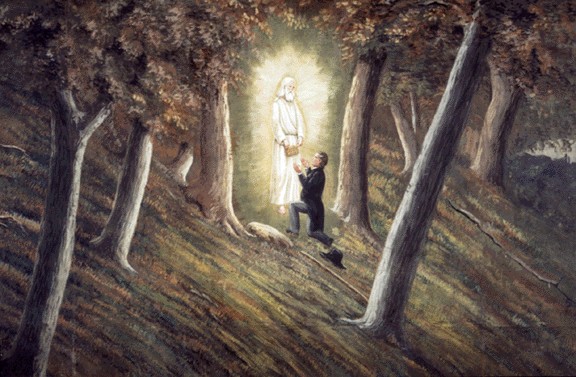
“And I saw another angel fly in the midst of heaven, having the everlasting gospel to preach unto them that dwell on the earth.” Image: C.C.A. Christensen, The Hill Cumorah
The lag in emphasizing the First Vision may have a few explanations. First, the vision itself was not a full prophetic call narrative but was really a conversion narrative and a confirmation that a general apostasy had occurred. In looking at all of the contemporary accounts of the First Vision, the only messages that God presented to Joseph Smith were that (1) God forgave his sins, (2) a general apostasy had occurred, (3) Joseph Smith shouldn’t join any existing churches, and (4) the Second Coming would occur soon. Only in the later accounts of the First Vision which were written when Joseph Smith was approaching the height of his prophetic career did he even mention hints of a prophetic call. In 1838, he stated that he was “one called of God” during the interim between the First Vision and the first visit of the Angel Moroni (JS-H 1:28), and in 1842, he wrote that he received “a promise that the fulness of the gospel should at some future time be made known unto” him during the First Vision.[4] It was left to Moroni’s visit to express Joseph’s explicit call to action as a prophet when he told Joseph that “God had a work for [him] to do” (JS-H 1:33). This was indicated by the fact that 1835 account of the First Vision was only considered a part of “a relation of the circumstances connected with the coming forth of the book of Mormon.”[5] Further, the forms in which Joseph Smith wrote the major narratives of the First Vision also indicate that it was a personal conversion experience in his own mind. For example, the 1832 account is written in the form of a Protestant “born again” spiritual autobiography, while the 1838 account is similar to Methodist conversion narratives of the time.[6]
Second, the narrative of the First Vision was not an entirely unique story for Christians in the time and place. Visionaries—a group or class of people who believed that the heavens opened sometimes to human view—and visionary culture were alive and well during Joseph Smith’s youth. The historian Richard Lyman Bushman found thirty-two pamphlets that relate visionary experiences published in the United States between 1783 and 1815 and noted that more could likely be found. These pamphlets were filled with apocalyptic warnings, heavenly journeys that led to repentance, and moments where the authors saw Christ or the devil.[7] Nor was Joseph Smith the first or last person to conclude that there had been an apostasy. Various individuals, such as Roger Williams expressed a desire to return to the Church of Christ as constituted in the New Testament as early as 1639, and Thomas Campbell raised a new standard in the form of an 1809 pamphlet entitled a “Declaration and Address” that advocated a “simple original form of Christianity,” stripped of any human additions in “doctrine, worship, discipline, and government” not found in the New Testament. Under the guidance of Thomas and Alexander Campbell, the Restorationist movement swelled in subsequent years with followers seeking to restore the ancient order of things.[8] With this in mind, the Methodist minister likely treated Joseph Smith’s story with contempt because he had heard stories like it before rather than out of shock at the audacity and originality of the claim.

What is significant, however, is that while many of the messages and elements contained in the story of the First Vision were already found in Joseph Smith’s environment, most were considered marginal or radical theologies that were rejected by mainline Christian churches. For example, personal revelation had been a hotly debated topic in Christianity because it always has the potential to lead to anarchy rather than order. Jonathan Edwards warned that “if this be supposed, that God does now in these days give to some revelations to be declared to others, let us consider what will be the consequences. . . . What a door is open to Satan! How the church of God is like a city broke down and without walls.”[9] As such, most established religions eschewed belief in such personal revelation, tending to side more with John Calvin’s belief that “the Spirit never dispensed revelation independent of the Word.”[10] In addition, the Enlightenment created a rationalist atmosphere where educated individuals viewed visionary experiences as superstitious and unbelievable. As such, they were relegated to the ignorant and credulous common people.[11] In fact, one of the complaints of the Missourians who drove Mormons from Jackson County was that the Mormons “do not blush to declare, and would not upon occasion hesitate to swear, that they have . . . converse with God and His angels,” indicating that a belief in visions and revelations was one reason why early Mormonism was viewed as both fanatical and heretical.[12]
The significance of the First Vision then, is its explicit and implicit confirmation of truths that set the beliefs and theology of the Church of Jesus Christ of Latter-day Saints apart from other Christian denominations. Richard Lyman Bushman has commented that Joseph Smith’s visionary and revelatory experiences differed because they “radically redirected people’s lives” and became incorporated into several worldwide faiths that are alive and well today. Other visionary experiences of his time were generally mere “titillations of the religious sensibilities that impose no obligations beyond a general revulsion against sin and responsiveness to divine purpose.”[13] The First Vision set the tone and direction of much that was to follow in Mormonism. The explicit messages from the vision described above include an affirmation of the Atonement of Jesus Christ, and the existence of the apostasy. Implicit messages found in the story include the reality of personal revelation and insights into the nature of God.

The First Vision set the tone and direction of much that was to follow in Mormonism
The earliest message that Joseph Smith focused on in retelling the First Vision was forgiveness of sins through the Atonement of Jesus Christ. The first hint of the First Vision we have is a passing reference to a time when “it was truly manifested unto this first elder that he had received a remission of his sins” (D&C 20:5). In the earliest extensive account of the First Vision, Joseph Smith recorded that he approached the Lord in part because he had “important concerns for the welfare of my immortal Soul” and “became convicted of my sins.” When the Lord spoke to Joseph in that account, the first message given was: “Joseph <my son> thy sins are forgiven thee. . . . Behold I am the Lord of glory I was crucifyed for the world that all those who believe on my name may have Eternal life.”[14] Likewise, in the 1835 account, Joseph recalled that the message of the Vision was that: “he said unto me thy sins are forgiven thee, he testifyed unto me that Jesus Christ is the son of God.”[15] Although not a restoration of a lost doctrine or a break from mainline Christian beliefs, it is fitting that this was the first message Joseph received at the dawn of the Dispensation of the Fulness of Times. The central purpose of the Church and gospel is to provide full access to the Atonement of Christ. As Joseph Smith would later write: “The fundamental principles of our religion is the testimony of the apostles and prophets concerning Jesus Christ, ‘that he died, was buried, and rose again the third day, and ascended up into heaven;’ and all other things are only appendages to these, which pertain to our religion.”[16] Joseph Smith gained a personal witness of the Atonement of Jesus Christ during the First Vision.
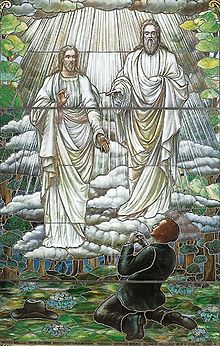
“Joseph <my son> thy sins are forgiven thee.”
The other main explicit message given by the Lord to Joseph Smith in the First Vision is that there had been an apostasy. Prior to the First Vision, Joseph Smith had concerns about being “prepared for a future state,”[17] and gained “intimate acquaintance with those of different denominations.” From this, he concluded that “mankind . . . had apostatized from the true and liveing faith and there was no society or denomination that built upon the gospel of Jesus Christ as recorded in the new testament.”[18] He believed that “if God had a church it would not be split up into factions, and that if he taught one society to worship one way, and administer in one set of ordinances, he would not teach another principles which were diametrically opposed.”[19] This was the central concern that Joseph sought answers about and also forms the burden of the Lord’s message to Joseph Smith. The Lord’s answer was that: “The world lieth in sin and at this time and none doeth good no not one they have turned asside from the gospel and keep not <my> commandments,”[20] and He stated that: “All religious denominations were believing in incorrect doctrines, and that none of them was acknowledged of God as his church and kingdom.”[21] “All their Creeds were an abomination in his sight, that those professors were all corrupt.” Joseph Smith also recalled that “he again forbade me to join with any of them” (JS-H 1:20).
This rejection of Christianity based on their doctrines and creeds is important because it provides the rationale for the work that Joseph Smith would do throughout the remainder of his life. As Elder B. H. Roberts stated: “[By] this great revelation . . . the errors of the age were swept aside and the ground cleared for the re-establishment of His Church in the earth.” Elder Roberts continued: “From the revelation referred to I learn that ‘Mormonism’ came into existence because there was an absolute necessity for a new dispensation of the Gospel, a re-establishment of the Church of Christ among men.”[22] In this manner, the First Vision paved the way for the establishment of the Church of Jesus Christ under the guidance of Joseph Smith the Prophet.
There are a number of implicit messages which may be drawn from the First Vision, but two of the most obvious and important messages are, to quote Ralph Waldo Emmerson, that: “God is, not was; that He speaketh, not spake.”[23] Elder B. H. Roberts explained this when he wrote that the First Vision “showed how mistaken the Christian world was in claiming that all revelation had ceased—that God would no more reveal himself to man” and that it “created a witness for God on the earth: a man lived who could say to some purpose that God lived and that Jesus was the Christ, for he had seen and talked with them.”[24] The First Vision has helped to shape a paradigm of revelation and our understanding of God Himself.
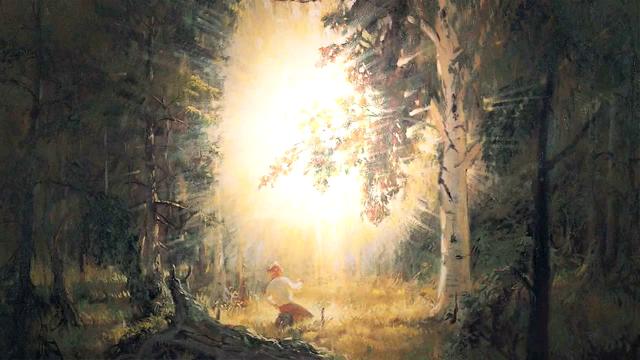
The First Vision has helped to shape a paradigm of revelation and our understanding of God Himself.
The First Vision established a revelatory paradigm that Joseph Smith would follow while acting as a prophet. Even though there is no indication that Joseph was called to serve as God’s mouthpiece on earth at the time of the First Vision, it did set up a precedent in his life that led to his calling. Joseph Smith recorded that after the First Vision had occurred, he felt that: “I had found the testimony of James to be true—that a man who lacked wisdom might ask of God, and obtain, and not be upbraided” (JS-H 1:26). Because of this confirmation, he “had full confidence in obtaining a divine manifestation, as I previously had one” when he sought “forgiveness of all my sins and follies, and also for a manifestation to me, that I might know of my state and standing before him” a few years later (JS-H 1:29). That later occasion led to a visit from the Angel Moroni, which led to the Book of Mormon coming forth and the beginning of Joseph Smith’s prophetic career. This in turn led to the organization of the Church and more revelations that shaped its structure and doctrines. Recognizing and experiencing the chaos inherent to many individuals being able to receive revelation, the Prophet confined the ability to receive revelation to guide the Church to the office of Church president and passed on this mantle to his successors. The prophetic office with individuals who follow Joseph’s pattern in receiving revelation is an important element that sets Mormonism apart from other Christian religions. As Charles Dickens observed in 1851, “Mormons seem to differ from other sects chiefly in believing the continued inspirations of their prophets.”[25] The process of receiving continued revelation that those prophets follow has its roots in the First Vision experience.
The First Vision functions not only as a prophetic paradigm for Church leaders but serves as a model for each of us to follow in seeking personal revelation. Joseph Smith was quite democratic in wanting others to share in revelatory experiences and to be able to commune with God on an individual basis. As Kathleen Flake once said: “Joseph Smith was the Henry Ford of revelation. He wanted every home to have one.”[26] While individual Mormons do not have the authority to guide the Church, they do believe that they have the opportunity to speak with God about their own lives and families. Again, the First Vision set the precedent for this in that Joseph Smith was not a prophet at the time but was still able to receive dialogic revelation with God in a way that is easy to follow. Speaking as a Mormon, my belief that God did indeed speak to Joseph Smith in answer to his own private concerns has galvanized my own belief that I can approach God and receive answers to questions and advice on how to best live my life, even if my experiences aren’t in the form of a grand theophany.
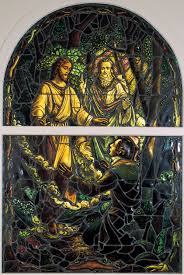
The First Vision, Redlands Temple
The most radical truths emerging from the First Vision, however, were centered on the very nature of God. As the scholar Sterling M. McMurrin wrote: “The most interesting thing about Mormon theology is that it incorporates a liberal doctrine of man and a radically unorthodox concept of God within the general framework of historic Christian fundamentalism,” which he noted “marks the distinctive character of the theology” of Mormonism.[27] Towards the end of his life, Joseph Smith articulated a profoundly different nature of God when compared to most of Christianity. He taught that each of the members of the Godhead were separate beings, that they are all in the form of human beings, and that they have physical bodies. It is difficult to determine the provenance of these ideas, especially since Joseph Smith never tied these teachings to the First Vision, but they may have emerged from his experience with God in the grove. During the First Vision, God declared that the Christian churches’ “creeds were an abomination in his sight” (JS-H 1:19). The creed that Joseph Smith would have been most familiar with would have been the Anglican Thirty-Nine Articles (1563) that explicitly emphasizes an ethereal, bodiless God: “There is but one only living and true God, everlasting, without body, parts, or passions.”[28] Christianity still has a lot of wonderful truths and Christians have done a lot of good in the world, but with the statement above in mind, God probably considered the Christian creeds abominable primarily for how He was understood within them.
The first point that was made clear concerning the nature of God during the First Vision was that members of the Godhead were distinct personages. In 1844, Joseph Smith proclaimed that: “I have always decl[are]d God to be a distinct personage—J[esus] C[hrist] a sep[arate] & distinct pers[on] from God the Fa[the]r. the H[oly] G[host] was a distinct personage & or Sp[irit] & these 3 constit[ute] 3 distinct personages & 3 Gods.”[29] In the First Vision, he recorded “a personage appeard . . . [then] another personage soon appeard like unto the first.”[30] After beholding these “two personages” he recalled that “one of <them> spake unto me calling me by name and said (pointing to the other) ‘This is my beloved Son, Hear him.’”[31] Both of these individuals were referred to as “the Lord” by Joseph Smith in the 1832 account, indicating that they were both godly beings—God the Father and the Son Jesus Christ. In addition, Joseph recorded that he was “filled with the spirit of god” and that his “soul was filled with love and for many days I could rejoice with great Joy and the Lord was with me,” indicting that he experienced the visitation or the third member of the Godhead as well.[32] Thus, when Joseph Smith taught that they were “3 distinct personages & 3 Gods” later on in life he could do so based on his experience in the First Vision.

The second notable truth about God that was confirmed in the First Vision was that members of the Godhead are beings in the shape and form of humans. Speaking later in life, Joseph Smith taught that: “God Himself who sits enthroned in yonder heavens is a Man like unto one of yourselves—that is the great secret! If the veil were rent today and the great God that holds this world in its sphere and the planets in their orbit and who upholds all things by His power—if you were to see Him today, you would see Him in all the person, image, fashion, and very form of a man, like yourselves. For Adam was a man formed in His likeness and created in the very fashion and image of God.”[33] This doctrine helps us to understand that, as Parley P. Pratt wrote, “God, angels and men are all of one species,”[34] and that God is our Heavenly Father. In the First Vision, Joseph “saw two glorious personages who exactly resembled each other in features, and likeness” who spoke with him in audible tones.[35] In one second-hand account, Joseph was even more explicit, describing “a personage” with a “light complexion blue eyes a piece of white cloth drawn over his shoulders his right arm bear.”[36] The First Vision, then, confirmed that human beings were literally created in the image of God.
Taking this idea further, Joseph Smith also taught that God and Christ had physical bodies of flesh and bone. As he said later in life: “The Son Had a Tabernicle & so had the father But the Holly Ghost is a personage of spirit without tabernicle.”[37] In a direct refutation of the Anglican Thirty-Nine Articles, he also stated: “That which is without body or parts is nothing. There is no other God in heaven but that God who has flesh and bones.”[38] Most accounts of the First Vision do not actually confirm that this is the case—Joseph only describes seeing and hearing God the Father and Jesus Christ while he was “enwrapped in a heavenly vision.”[39] Yet, one recollection recorded decades later recalled that “God touched his eyes with his finger and said ‘Joseph this is my beloved Son hear him.’ As soon as the Lord had touched his eyes with his finger he immediately saw the Savior.” John Alger—who made this recollection—said that “Joseph while speaking of it put his finger to his right eye, suiting the action with the words so as to illustrate.”[40] If this source is reliable, then Joseph Smith’s teachings concerning God’s corporeality may be rooted in the First Vision experience.

1976 BYU Film of the First Vision
In recent decades, historical research into the roots of Mormonism has led to a number of challenges to the place First Vision holds in Mormon thought. The most direct challenges to the First Vision have targeted whether the event actually occurred. The basis for these challenges are rooted in the fact that the firsthand accounts were written one to two decades after the First Vision took place, there are discrepancies in the several different accounts recorded by Joseph Smith and his associates, and that the histories of the time may not always line up with Joseph Smith’s recollections of the settings of the First Vision. These have been addressed a number of times by faithful and believing members. There are, however, subtler challenges to the First Vision that do not deny that it occurred, but have the potential to undermine its significance. First, the vision was not prominent in Mormon discourse until fifty years after the Church was founded, demonstrating that it is not absolutely necessary for it to hold the foundational significance it is regarded with today. Second, the First Vision was not a unique occurrence—many individuals in America at the turn of the nineteenth century reported having visions, some of which involved seeing God and being told that there had been an apostasy. Third, the vision was primarily considered to be a personal conversion narrative to Joseph Smith and not a prophetic call.
Even in light of these challenges, the First Vision may be seen as significant because it confirmed and taught Joseph Smith a number of significant truths that set Mormonism apart from most other Christian denominations. It confirmed once more the reality of God and of the Atonement of Jesus Christ. It confirmed that the Great Apostasy had occurred, making a restoration of the Church of Jesus Christ necessary. It established a revelatory precedent that prophets and saints alike follow to commune with God. It also laid the foundation for a number of radical departures that Mormon theology has taken relative to the nature of God. Many of the important distinctions that sets Mormonism apart have their root in what Gordon B. Hinckley called “the great curtain-raiser on the dispensation of the fulness of times”—the First Vision.[41]

The First Vision by Walter Rane
[1] See James B. Allen, “Emergence of a Fundamental: The Expanding Role of Joseph Smith’s First Vision in Mormon Religious Thought,” Journal of Mormon History, 7 (1980): 43-61.
[2] Joseph Smith Jr., sermon, 11 June 1843, in Andrew F. Ehat and Lyndon W. Cook, The Words of Joseph Smith: The Contemporary Accounts of the Nauvoo Discourses of the Prophet Joseph (Provo, UT: Grandin Book Company, 1991), 209-216.
[3] See Allen, “Emergence of a Fundamental.”
[4] ““Church History,” 1 March 1842,” p. 706, The Joseph Smith Papers, accessed October 5, 2016, http://www.josephsmithpapers.org/paper-summary/church-history-1-march-1842/1
[5] “Journal, 1835–1836,” p. 23, The Joseph Smith Papers, accessed October 5, 2016, http://www.josephsmithpapers.org/paper-summary/journal-1835-1836/24
[6] See Neal E. Lambert and Richard H. Cracroft, “Literary Form and Historical Understanding: Joseph Smith’s First Vision,” Journal of Mormon History, 7 (1980): 31-42; Christopher C. Jones, “The Power and Form of Godliness: Methodist Conversion Narratives and Joseph Smith’s First Vision,” Journal of Mormon History 37 (Spring 2011): 88-114.
[7] Richard Lyman Bushman, “The Visionary World of Joseph Smith,” BYU Studies 37, no. 1 (1997-1998), 183-204.
[8] Thomas Campbell, Declaration and Address of the Christian Association of Washington (Washington, PA.: Brown & Sample, 1809), 4. Cited in Terryl L. Givens and Matthew J. Grow, Parley P. Pratt: The Apostle Paul of Mormonism (New York: Oxford University Press, 2011), 22.
[9] Jonathan Edwards, cited in Terryl L. Givens, Wrestling the Angel: The Foundations of Mormon Thought: Cosmos, God, Humanity (New York: Oxford University Press, 2015), 77.
[10] E. Brooks Holifield, Theology in America (New Haven: Yale University Press, 2003), 34.
[11] See Bushman, “Visionary World,” 183-204.
[12] Cited in Terryl L. Givens, The Viper on the Hearth: Mormons, Myths, and the Construction Heresy (New York: Oxford University Press, 1997), 44.
[13] Bushman, “Visionary World,” 193-194.
[14] “History, circa Summer 1832,” pp. 2-3, The Joseph Smith Papers, accessed October 5, 2016, http://www.josephsmithpapers.org/paper-summary/history-circa-summer-1832/2
[15] “Journal, 1835–1836,” p. 24, The Joseph Smith Papers, accessed October 5, 2016, http://www.josephsmithpapers.org/paper-summary/journal-1835-1836/25
[16] Elder’s Journal, Vol.1, No.3 (July 1838): 42-44.
[17] ““Church History,” 1 March 1842,” p. 706, The Joseph Smith Papers, accessed October 5, 2016, http://www.josephsmithpapers.org/paper-summary/church-history-1-march-1842/1
[18] “History, circa Summer 1832,” p. 2, The Joseph Smith Papers, accessed October 5, 2016, http://www.josephsmithpapers.org/paper-summary/history-circa-summer-1832/2
[19] ““Church History,” 1 March 1842,” p. 706, The Joseph Smith Papers, accessed October 5, 2016, http://www.josephsmithpapers.org/paper-summary/church-history-1-march-1842/1
[20] “History, circa Summer 1832,” p. 3, The Joseph Smith Papers, accessed October 5, 2016, http://www.josephsmithpapers.org/paper-summary/history-circa-summer-1832/3
[21] ““Church History,” 1 March 1842,” p. 707, The Joseph Smith Papers, accessed October 5, 2016, http://www.josephsmithpapers.org/paper-summary/church-history-1-march-1842/2
[22] B. H. Roberts, Address, General Conference Report, April 1906, 13-14.
[23] The Complete Essays and Other Writings of Ralph Waldo Emerson, ed. Brooks Atkinson (1940), 75, 71, 80
[24] B. H. Roberts, Outlines of Ecclesiastical History (Salt Lake City: George Q. Cannon & Sons Company, 1893), 307-308.
[25] Charles Dickens, “In the Name of the Prophet—Smith!,” Household Words 8 (19 July 1851), 342.
[26] Interview Kathleen Flake, “Meet the Mormons,” PBS, http://www.pbs.org/mormons/interviews/flake.html. Henry Ford wanted a car in every home.
[27] Sterling M. McMurrin, The Theological Foundations of the Mormon Religion (Salt Lake City: University of Utah Press, 1965), ix.
[28] Philip Schaff, The Creeds of Christendom: The Evangelical Protestant Creeds (New York: Harper & Brothers, 1877), 487, cited in Terryl Givens, “The Woman in the Wilderness: Mormonism, Catholicism, and Inspired Syncretism” Notre Dame, 5 December 2013, 17-18, accessed October 5, 2016, http://terrylgivens.com/pdfs/The-Woman-in-the-Wilderness.pdf
[29] Joseph Smith Jr., sermon, 16 June 1844, in Ehat and Cook, The Words of Joseph Smith, 378.
[30] “Journal, 1835–1836,” p. 24, The Joseph Smith Papers, accessed October 5, 2016, http://www.josephsmithpapers.org/paper-summary/journal-1835-1836/25
[31] “History, circa June 1839–circa 1841 [Draft 2],” p. 3, The Joseph Smith Papers, accessed October 5, 2016, http://www.josephsmithpapers.org/paper-summary/history-circa-june-1839-circa-1841-draft-2/3
[32] “History, circa Summer 1832,” p. 3, The Joseph Smith Papers, accessed October 5, 2016, http://www.josephsmithpapers.org/paper-summary/history-circa-summer-1832/3
[33] Joseph Smith Jr., Sermon 7 April 1844, Stan Larson, “The King Follett Discourse: A Newly Amalgamated Text,” BYU Studies 18, no. 2 (1978), 7.
[34] Parley P. Pratt, Key to the Science of Theology (Liverpool: F. D. Richards, 1855), 33.
[35] ““Church History,” 1 March 1842,” p. 707, The Joseph Smith Papers, accessed October 5, 2016, http://www.josephsmithpapers.org/paper-summary/church-history-1-march-1842/2
[36] “Alexander Neibaur, Journal, 24 May 1844, extract,” p. [23], The Joseph Smith Papers, accessed October 5, 2016, http://www.josephsmithpapers.org/paper-summary/alexander-neibaur-journal-24-may-1844-extract/1
[37] Joseph Smith Jr., sermon, 9 March 1841, in Ehat and Cook, The Words of Joseph Smith, 64.
[38] Joseph Smith Jr., sermon, 5 January 1841, in Ehat and Cook, The Words of Joseph Smith, 60.
[39] ““Church History,” 1 March 1842,” pp. 706-707, The Joseph Smith Papers, accessed October 5, 2016, http://www.josephsmithpapers.org/paper-summary/church-history-1-march-1842/1
[40] Karl Larson and Katharine Miles Larson, eds., Diary of Charles Lowell Walker (Logan, UT: Utah State University Press, 1980), 2:755–56 [recorded 2 February 1893].
[41] Gordon B. Hinckley, Teachings of Gordon B. Hinckley (Salt Lake City: Deseret Book Company, 1997), 226.
